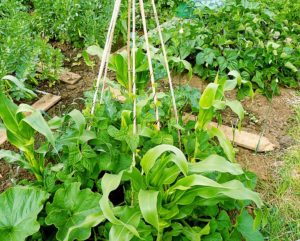
Here’s the Dirt on Companion Planting
The Three Sisters: squash, corn, and climbing beans.
Photo: Christian Guthier/Flickr
By Thomas Christopher
Sometimes common knowledge, what everybody knows to be true, just isn’t. That’s the case, I’ve found, with much of the broadly accepted information about companion planting.
Companion planting is the theory that certain plants grow better in association with each other. You’ve undoubtedly heard nuggets of information such as tomatoes “like” basil; that is, growing tomatoes in association with basil makes both crops taste better. Similarly, chives and carrots supposedly like each other.
Where does such information come from? That’s what I began to wonder a number of years ago. Occasionally, I found that the plant companions were part of some clearly defined gardening tradition. The “three sisters,” for example, the practice of planting corn, beans, and squashes together, was recorded by European colonists as a Native American Iroquois practice. It’s easy to understand the advantage that could derive from this particular interplanting. Corn has a big appetite for nitrates, and beans are legumes which absorb nitrogen gas directly from the atmosphere and convert it into nitrates useful to plants. The corn stalks in turn provide a trellis for the beans. The squash, for its part, covers the ground with a blanket of foliage, which serves as a living mulch to keep the roots of all three plants cooler, and the soil more moist, while discouraging weed growth.
But why should tomatoes like basil? Typically, the sharer of this information couldn’t say. I went to organic gardening literature, which usually just presented the companion planting combinations as fact. By comparing many different accounts of companion planting, however, I eventually identified a source. A number of the books credited Ehrenfried Pfeiffer as an originator of companion planting know-how.
A trip to the New York Botanical Garden Library revealed who this mysterious authority was. Ehrenfried Pfeiffer was a German immigrant who was a disciple of Rudolf Steiner, a late 19th century, early 20th century Austrian philosopher and mystic, who among other activities founded biodynamic gardening. Pfeiffer was one of only a handful of people that Steiner entrusted with making his biodynamic “preparations,” such as preparation #502 which called for yarrow blossoms to be stuffed inside the urinary bladder of a red deer and exposed to the sun over the summer, then buried over the winter before being exhumed and used to inoculate the compost heap.
At Steiner’s behest Pfeiffer also developed a procedure he called “sensitive crystallization.” In this process, he would mix some biological extract with a solution of copper chloride and pour the result into a petri dish to observe the pattern of crystals that formed as the liquid evaporated. He applied this process largely to the study of plants. If the plant extract contributed to a clear and orderly pattern of crystals, Pfeiffer judged this to be a sign the plant was healthy. If the pattern was unclear or disorganized, Pfeiffer took this as proof that the plant was unhealthy. When two plant extracts were combined with the copper chloride solution, an attractive pattern was proof that the plants were compatible and should be grown together.
Pfeiffer’s observations were collected and published as companion planting lists. Picked up and endorsed by J. I. Rodale, an early leader of the American organic gardening movement, these lists of supposedly compatible plants became a popular tool of organic gardeners, who usually did not know of the nature of their origin. Passed down from book to book, Pfeiffer’s dubious findings are still promulgated as gospel today.
Does this mean that companion planting cannot be advantageous? Of course not. I do believe for example, that the Iroquois were on to something with their three sisters. Likewise, I have found in two books by Robert Kourik, a Californian organic gardener whom I greatly admire, citations of scientifically conducted studies of interplanting that did prove to genuinely benefit the plants involved. Both Designing and Maintaining Your Edible Landscape Naturally (Chelsea Green,1986), and the more recent, whimsically named Lazy-Ass Gardening (Metamorphic Press, 2019) contain much relevant factual information, including Kourik’s finding that companion plantings proved to be regional in their validity. He has also found that one of the most effective uses of companion plants was to include in your garden flowers that attract predaceous insects. Including sweet alyssum (Lobularia maritima), for example, attracted hoverflies whose larvae prey on aphids. Such plantings do not need to be right beside the plants to be protected – one study that Kourik cites found that the predacious insects would venture some 25 meters (82 feet) from the improved habitat.

 Thomas Christopher is the co-author of “Garden Revolution” (Timber Press, 2016) and is a volunteer at Berkshire Botanical Garden. berkshirebotanical.org Be-a-Better-Gardener is a community service of Berkshire Botanical Garden, one of the nation’s oldest botanical gardens in Stockbridge, MA. Its mission to provide knowledge of gardening and the environment through 25 display gardens and a diverse range of classes informs and inspires thousands of students and visitors on horticultural topics every year. Thomas Christopher is the co-author of Garden Revolution (Timber press, 2016) and is a volunteer at Berkshire Botanical Garden. berkshirebotanical.org.
Thomas Christopher is the co-author of “Garden Revolution” (Timber Press, 2016) and is a volunteer at Berkshire Botanical Garden. berkshirebotanical.org Be-a-Better-Gardener is a community service of Berkshire Botanical Garden, one of the nation’s oldest botanical gardens in Stockbridge, MA. Its mission to provide knowledge of gardening and the environment through 25 display gardens and a diverse range of classes informs and inspires thousands of students and visitors on horticultural topics every year. Thomas Christopher is the co-author of Garden Revolution (Timber press, 2016) and is a volunteer at Berkshire Botanical Garden. berkshirebotanical.org.

